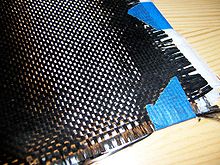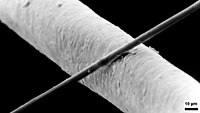Carbon fibers: Difference between revisions
Carbonfibguy (talk | contribs) added a clearer and more broad defintion of carbon fiber |
Carbonfibguy (talk | contribs) No edit summary |
||
| Line 1: | Line 1: | ||
{{refimprove|date=April 2007}} |
{{refimprove|date=April 2007}} |
||
[[Image:Kohlenstofffasermatte.jpg|thumb|A cloth of woven carbon filaments]] |
[[Image:Kohlenstofffasermatte.jpg|thumb|A cloth of woven carbon filaments]] |
||
[[Image:http://www.advantageavionics.com/Carbon_Fiber_Panel-004.jpg]] |
|||
[[Image:a.bmp]] |
|||
== Headline text == |
|||
'''Carbon fibre''' or '''carbon fiber''' (See [[American and British English spelling differences|spelling differences]]) can refer to carbon filament thread, or to felt or woven cloth made from those carbon filaments. By extension, it is also used informally to mean any [[composite material]] made with carbon filament; for more on that application, see [[Carbon fiber reinforced plastic|Carbon fiber reinforced polymer or CFRP]]. |
'''Carbon fibre''' or '''carbon fiber''' (See [[American and British English spelling differences|spelling differences]]) can refer to carbon filament thread, or to felt or woven cloth made from those carbon filaments. By extension, it is also used informally to mean any [[composite material]] made with carbon filament; for more on that application, see [[Carbon fiber reinforced plastic|Carbon fiber reinforced polymer or CFRP]]. |
||
Revision as of 17:53, 30 November 2007
This article needs additional citations for verification. (April 2007) |

File:Http://www.advantageavionics.com/Carbon Fiber Panel-004.jpg
Headline text
Carbon fibre or carbon fiber (See spelling differences) can refer to carbon filament thread, or to felt or woven cloth made from those carbon filaments. By extension, it is also used informally to mean any composite material made with carbon filament; for more on that application, see Carbon fiber reinforced polymer or CFRP.
Structure and properties

Carbon fibers are the closest to asbestos in a number of properties. (http://www.wtec.org/loyola/compce/02_02.htm) Each carbon filament thread is a bundle of many thousand carbon filaments. A single such filament is a thin tube with a diameter of 5–8 micrometers and consists almost exclusively of carbon.
The atomic structure of carbon fiber is similar to that of graphite, consisting of sheets of carbon atoms (graphene sheets) arranged in a regular hexagonal pattern. The difference lies in the way these sheets interlock. Graphite is a crystalline material in which the sheets are stacked parallel to one another in regular fashion. The chemical bonds between the sheets are relatively weak, giving graphite its soft and brittle characteristics. Depending upon the precursor to make the fiber, carbon fiber may be turbostratic or graphitic, or have a hybrid structure with both graphitic and turbostratic parts present. In turbostratic carbon fiber, the sheets of carbon atoms are haphazardly folded, or crumpled, together. Carbon fibers derived from PAN are turbostratic, whereas carbon fibers derived from mesophase pitch are graphitic after heat treatment at temperatures exceeding 2200 C. Turbostratic carbon fibers tend to have high tensile strength, wheresas heat-treated mesophase-pitch-derived carbon fibers have high Young's modulus and high thermal conductivity.
Applications
(For common applications, see Carbon fiber reinforced polymer or CFRP)
Carbon fiber is most notably used to reinforce composite materials, particularly the class of materials known as Carbon fiber or graphite reinforced polymers.
Non-polymer materials can also be used as the matrix for carbon fibres. Due to the formation of metal carbides (i.e., water-soluble AlC) and corrosion considerations, carbon has seen limited success in metal matrix composite applications. Reinforced carbon-carbon (RCC) consists of carbon fibre-reinforced graphite, and is used structurally in high-temperature applications. The fibre also finds use in filtration of high-temperature gases, as an electrode with high surface area and impeccable corrosion resistance, and as an anti-static component.
Synthesis
Each carbon filament is made out of long, thin filaments of carbon sometimes transformed to graphite. A common method of making carbon filaments is the oxidation and thermal pyrolysis of polyacrylonitrile (PAN), a polymer based on acrylonitrile used in the creation of synthetic materials. Like all polymers, polyacrylonitrile molecules are long chains, which are aligned in the process of drawing continuous filaments. When heated in the correct conditions, these chains bond side-to-side (ladder polymers), forming narrow graphene sheets which eventually merge to form a single, jelly roll-shaped or round filament. The result is usually 93-95% carbon. Lower-quality fibre can be manufactured using pitch or rayon as the precursor instead of PAN. The carbon can become further enhanced, as high modulus, or high strength carbon, by heat treatment processes. Carbon heated in the range of 1500-2000 °C (carbonization) exhibits the highest tensile strength (820,000 psi or 5,650 MPa or 5,650 N/mm²), while carbon fibre heated from 2500 to 3000 °C (graphitizing) exhibits a higher modulus of elasticity (77,000,000 psi or 531 GPa or 531 kN/mm²).
Textile
There are several categories of carbon fibres: standard modulus (250 GPa) , intermediate modulus (300 GPa), and high modulus (> 300 GPa). The tensile strength of different yarn types varies between 2000 and 7000 MPa. A typical density of carbon fiber is 1750 kg/m3.
Precursors for carbon fibres are PAN, rayon and pitch. Carbon fiber filament yarns are used in several processing techniques: the direct uses are for prepregging, filament winding, pultrusion, weaving, braiding etc. Carbon fiber yarn is rated by the linear density (weight per unit length = 1 g/1000 m = tex) or by number of filaments per yarn count, in thousands. For example 200 tex for 3,000 filaments of carbon fiber is 3 times as strong as 1,000 carbon fibers, but is also 3 times as heavy. This thread can then be used to weave a carbon fiber filament fabric or cloth. The appearance of this fabric generally depends on the linear density of the yarn and the weave chosen. Some commonly used types of weave are twill, satin and plain.
